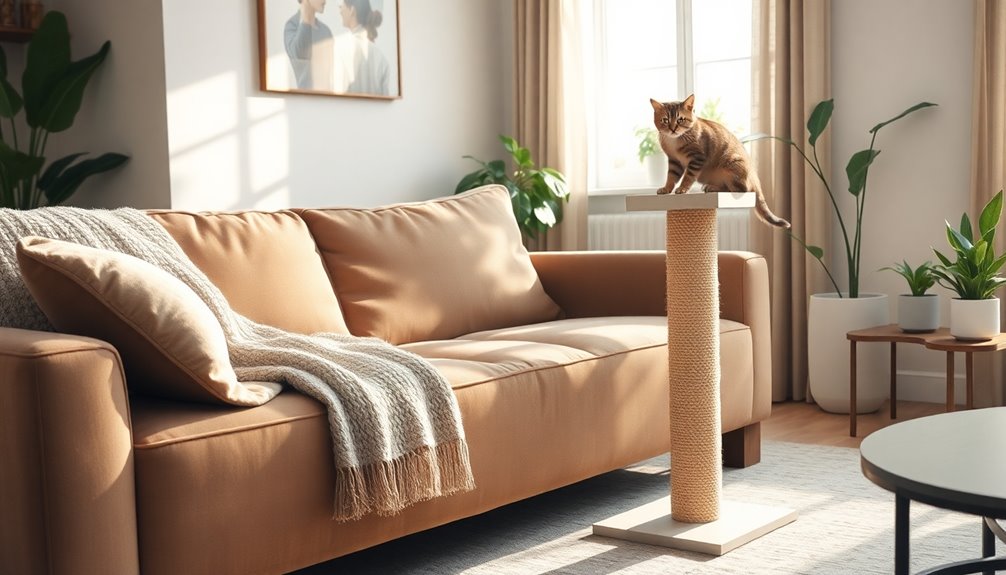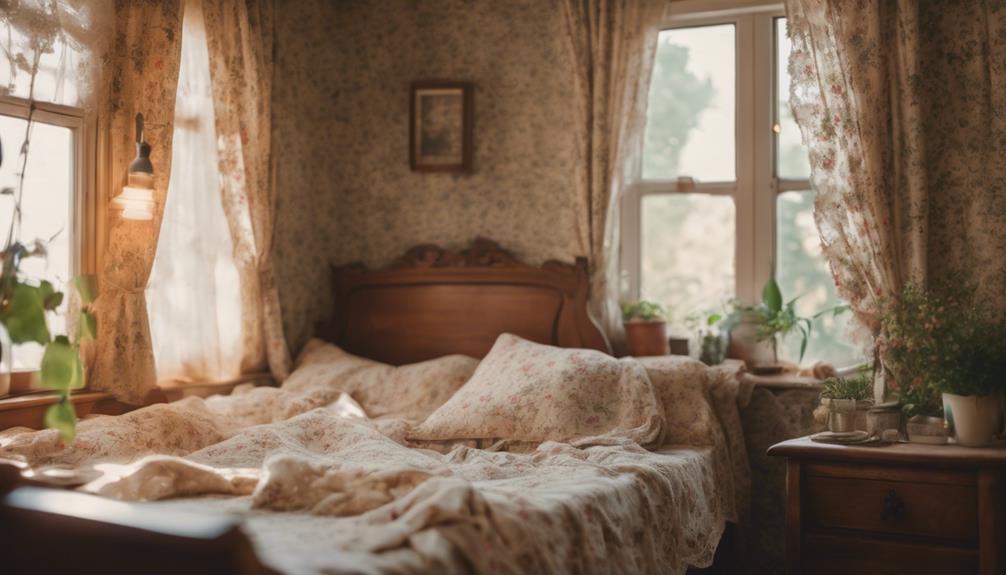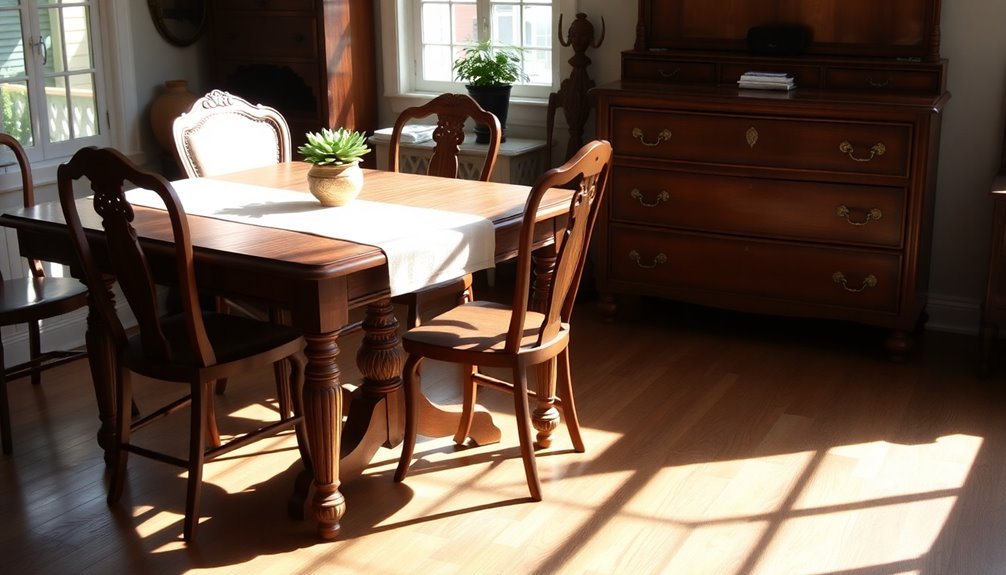To protect your sofa from cat scratching, start by understanding your cat’s natural behavior. Provide sturdy scratching posts and pads to redirect their instincts. Choose scratch-resistant fabrics like microfiber or canvas for your sofa and consider using washable covers or stylish throws for added protection. Regularly inspect your upholstery and reinforce any weak seams. Keep your cat’s nails trimmed to minimize potential damage. You can even employ deterrents like double-sided tape on furniture. These strategies not only safeguard your sofa but also contribute to a harmonious home. You’ll discover even more effective tips ahead. Additionally, establishing a designated play area for your cat can help satisfy their need to scratch and explore. You may also want to consider pheromone sprays or calming diffusers to reduce anxiety that may lead to scratching. By following these strategies, you can effectively protect your sofa from cats while maintaining a beautiful and comfortable living space.
Key Takeaways
- Use durable, scratch-resistant fabrics like microfiber or canvas to minimize damage from cat claws.
- Provide multiple scratching posts made from sisal or cardboard to redirect your cat's scratching behavior.
- Apply protective slipcovers or washable sofa covers to safeguard upholstery from scratches and stains.
- Regularly trim your cat's nails every two to three weeks to reduce potential furniture damage.
- Implement positive reinforcement training by rewarding your cat for using designated scratching surfaces instead of the sofa.
Introduction
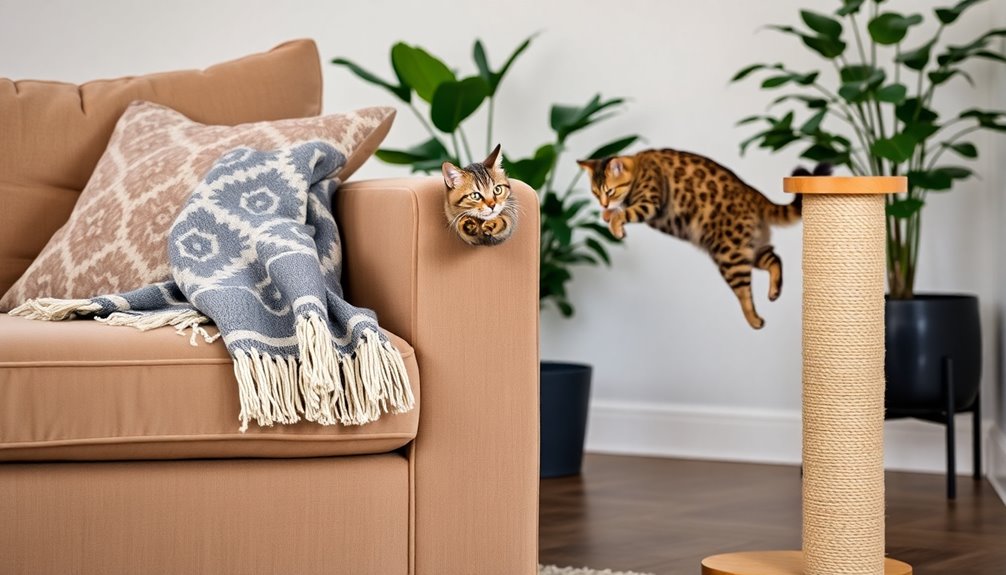
Keeping your sofa in great shape means regularly inspecting the upholstery for any signs of wear and tear. You'll also want to use fabric-specific cleaning techniques to tackle any stains, including those pesky cat urine marks. By staying proactive, you can enjoy your furniture without worrying about damage.
Routine Upholstery Inspections
Routine upholstery inspections are essential for maintaining the integrity of your sofa, especially if you share your home with a cat. Regularly inspecting your upholstery helps you identify signs of wear, damage, or potential scratching points. Look for loose threads, frayed edges, or areas of heavy use that might attract your cat's scratching behavior. These indicators show where additional protection is necessary.
Pay special attention to seams and corners; these are common spots where cats tend to scratch. Reinforcing these areas can significantly help in preventing further damage. Document the condition of your upholstery periodically to monitor changes over time. This can inform your decisions about protective coverings or furniture guards.
Consider using furniture protectors from cats during your inspections. This way, you can safeguard your sofa while evaluating its condition. By taking these proactive steps, you can protect your furniture without compromising its appearance or comfort. Regular inspections will not only prolong the life of your sofa but also help create a harmonious environment for both you and your feline friend.
Fabric-Specific Cleaning Techniques
When it comes to maintaining your sofa's appearance, understanding fabric-specific cleaning techniques is crucial. Each type of upholstery requires a tailored approach to effectively remove stains and preserve its integrity. For cotton upholstery, mix mild soap and water to gently scrub the fabric, but always test in an inconspicuous area first to avoid discoloration. If your sofa features synthetic fabrics like polyester, a solution of white vinegar and water works wonders for cleaning without causing damage.
When it comes to leather or faux leather, use a damp cloth with a few drops of dish soap, then follow up with a conditioner to keep the material supple and prevent cracks. For delicate fabrics such as silk, dab with a cloth soaked in a gentle fabric cleaner, being careful not to soak the material to prevent water stains.
Lastly, always check the manufacturer's cleaning instructions for your specific fabric type, as different materials may require specialized care methods. By using these fabric-specific cleaning techniques, you'll ensure your sofa remains looking its best while minimizing the impact of your cat's scratching habits.
Treating Cat Urine Stains
Dealing with cat urine stains can be a frustrating experience, especially given their strong odor and potential to cause lasting damage to your sofa. It's essential to act quickly; older stains can become more challenging to remove, leading to permanent discoloration. To effectively treat these stains, consider using enzymatic cleaners. These specialized products break down the proteins in cat urine, neutralizing odors and preventing your feline friend from marking the same spot again.
Before applying any cleaner, always test it on an inconspicuous area of your sofa. You want to ensure the fabric won't become discolored or damaged. After applying the enzymatic cleaner, rinse the area thoroughly with water and blot it dry. This step is crucial, as any residues left behind can attract your cat back to the same spot, potentially leading to more furniture scratching.
If cat behavior persists, consulting a cat behavior consultant might help you understand the underlying reasons for your cat's actions. Additionally, investing in protectors for cats can safeguard your furniture while you manage these challenges, keeping your sofa looking fresh and intact.
Sofa Fabric Guarding Strategies
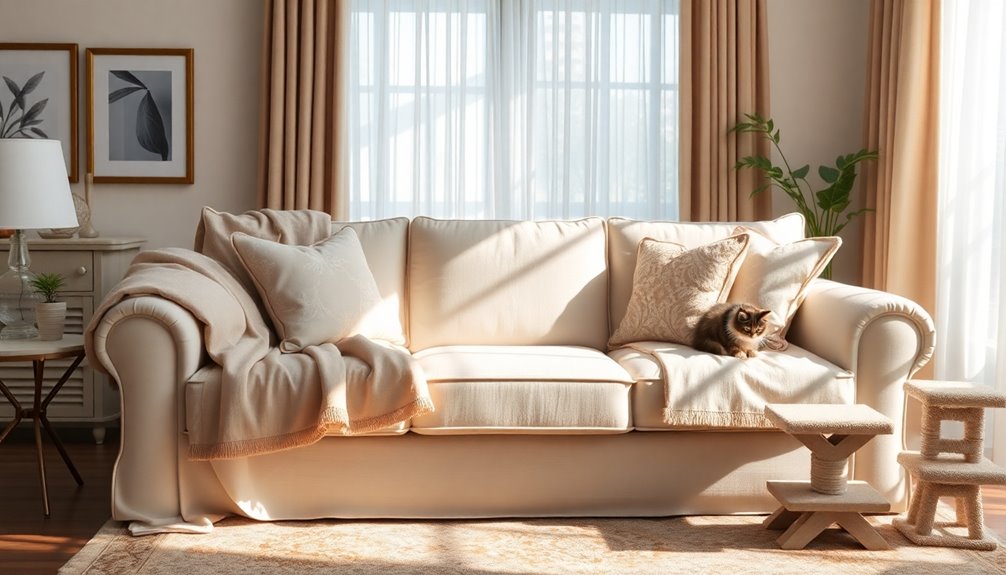
When choosing a sofa, consider scratch-resistant fabrics that can withstand your cat's claws. You can also enhance protection with stylish throws that not only look great but guard against damage. Finally, learn how to minimize fabric damage to keep your sofa looking new for longer. Additionally, incorporating slipcovers for added protection can help maintain your sofa's appearance while providing a layer of defense against scratches.
Scratch-Resistant Fabric Selection
Choosing the right fabric for your sofa is crucial if you want to protect it from cat scratching. Start by opting for tightly woven materials like microfiber or canvas, which are more resistant to claw damage and easier to maintain. These fabrics have a tighter weave that helps prevent your cat's claws from snagging.
Consider synthetic fibers, such as polyester or nylon, as they tend to be more durable and less likely to fray compared to natural fibers like cotton or linen. Look for upholstery specifically labeled as "scratch-resistant" or "pet-friendly." These materials are designed to withstand the wear and tear caused by your feline friend.
Darker colors or patterned fabrics can also be a smart choice since they help disguise any potential scratches or wear, making them less noticeable over time. Finally, regularly maintaining and cleaning your sofa with pet-safe products will help preserve the fabric's integrity and prolong its lifespan against scratching. By carefully selecting the right upholstery, you'll create a cozy space that both you and your cat can enjoy without constant worry about claw damage.
Fabric Protection With Stylish Throws
Adding stylish throws to your sofa not only enhances its aesthetic appeal but also provides an effective layer of protection against cat scratching. By choosing throws made from durable materials, you can safeguard your fabric sofa from potential claw damage. A well-chosen throw acts as a protective layer, absorbing the brunt of your cat's playful antics while adding a touch of elegance to your living space.
To achieve a cohesive look, select throws that complement your existing furniture colors and patterns. This way, you won't sacrifice style for functionality; instead, you'll create a harmonious decor that invites both humans and pets to relax. Remember, regular rotation and washing of these throws is essential to maintain their appearance and extend their lifespan as a protective barrier against cat claws. Moreover, using durable materials for your throws can significantly enhance their effectiveness at preventing wear and tear.
Additionally, these throws provide an extra layer of comfort, making your sofa an inviting spot for everyone. With a few stylish throws, you'll not only protect your investment but also elevate the overall ambiance of your home. So, embrace this dual-purpose solution and enjoy a beautiful, cat-friendly space!
Minimizing Fabric Damage
Protecting your sofa from cat scratches goes beyond stylish throws. You need effective strategies to minimize fabric damage. Start by investing in a durable furniture protector like Clawguard, which offers a transparent barrier against scratching while keeping your sofa looking great. Additionally, applying double-sided sticky tape, such as Sticky Paws, on vulnerable areas can deter your cat from scratching by creating an unpleasant texture without causing distress.
Consider incorporating cat scratch guards or scratching posts that fit snugly against corners or legs of your sofa. This provides your cat with a designated scratching area, redirecting their instinctual behavior away from the fabric. Regularly trimming your cat's nails every two to three weeks can also significantly reduce potential damage.
Lastly, don't underestimate the power of washable sofa covers made from durable materials. They protect your sofa against scratches while being easy to maintain, offering a cost-effective solution compared to reupholstering. By combining these strategies, you can keep your sofa looking pristine while allowing your feline friend to indulge in their natural scratching instincts.
Upholstery Stitching Repairs
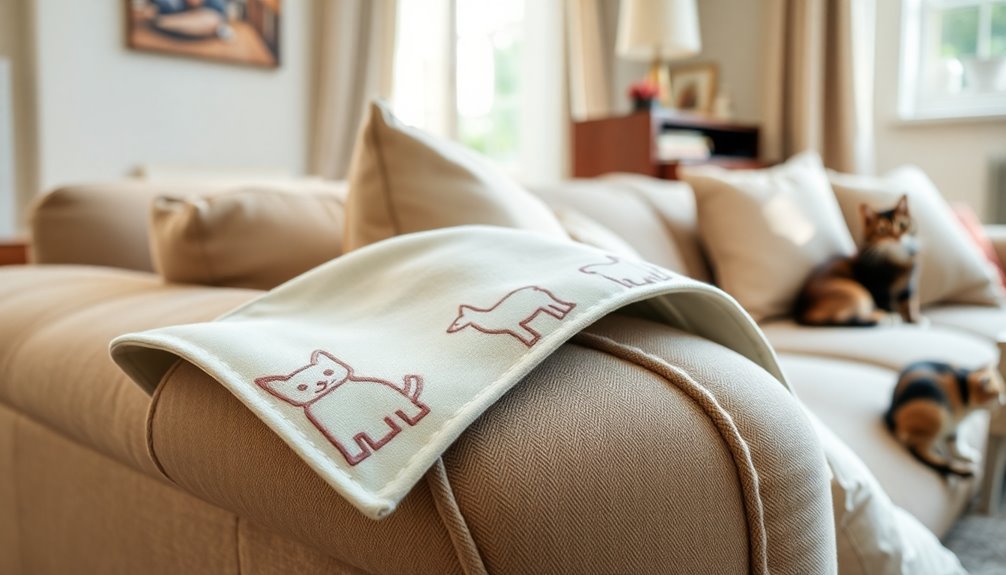
When it comes to upholstery stitching repairs, addressing frame integrity is crucial to ensure your sofa remains sturdy. You'll also want to consider leather repair techniques if your furniture is made of leather, as they require specific care. Plus, enhancing cushioning can greatly improve relaxation, making your sofa not just a stylish piece but a comfortable one too.
Frame Integrity Concerns
Cat scratching can wreak havoc on your sofa's upholstery, leading to costly repairs that can set you back between $100 and $300. Regular scratching can cause fraying and tearing of the upholstery seams, which compromises the frame integrity of your furniture. Over time, this damage can worsen if not addressed, making it crucial to take preventive measures.
To protect your sofa, consider using protective covers or furniture guards. These options can help mitigate scratching risks and preserve the integrity of your upholstery stitching. Additionally, identify stress points on your sofa, like corners and edges, where damage is more likely to occur. Reinforced stitching techniques can also enhance durability and reduce the chances of damage from your cat's claws.
When selecting scratching options for your feline friend, provide alternative surfaces that are more enticing than your furniture. Scratching posts or pads can divert their attention away from your sofa, helping to keep it looking new for longer. By taking these steps, you not only protect your sofa but also maintain its frame integrity, ensuring it remains a valuable part of your home for years to come.
Leather Repair Techniques
Damage from cat scratching can lead to the need for upholstery stitching repairs, especially on leather sofas. When you notice small tears or frays, grab a needle and some leather-specific thread that matches your sofa's color and texture. Use a whip stitch to sew the leather back together, reinforcing the area and preventing further damage.
For significant tears, you'll want to consider using a leather adhesive along with your stitches. This combination not only repairs the tear but also adds strength and durability to the area. Make sure to apply the adhesive carefully, following the instructions to achieve the best bond.
After completing your repairs, regular maintenance is key. Conditioning your leather can help prevent future wear and tear, making any upcoming repairs easier and more effective. It's a good idea to incorporate conditioning into your cleaning routine, keeping your leather supple and reducing the risk of further damage from scratching.
Cushioning for Enhanced Relaxation
Over time, your sofa's comfort can diminish due to wear and tear, especially from cat scratches that compromise its structure. To maintain your couch's integrity, upholstery stitching repairs are vital. Regularly inspecting and reinforcing stitching can prevent larger tears, extending your sofa's life and saving you costly repairs.
When you notice fraying or weakened seams, don't hesitate to act. Using a strong, durable thread that matches your fabric enhances repairs, ensuring they withstand your cat's scratching. Additionally, consider applying a fabric guard spray after repairs to create a barrier against future damage.
To further protect your furniture from cat scratches, invest in an anti-scratch furniture protector or a couch protector. These protective solutions can help keep your sofa looking great while preventing wear. You might also find scratch tape useful for vulnerable areas. Furthermore, regular maintenance enhances vacuum lifespan and performance, which can be beneficial in maintaining cleanliness around your sofa.
For more complex issues, seek professional upholstery services. They provide specialized stitching repairs that not only restore your sofa's appearance but also reinforce the most susceptible areas. By taking these steps, you can enhance your sofa's comfort and longevity while keeping it safe from your feline friend.
Personalized Sofa Protection Solutions
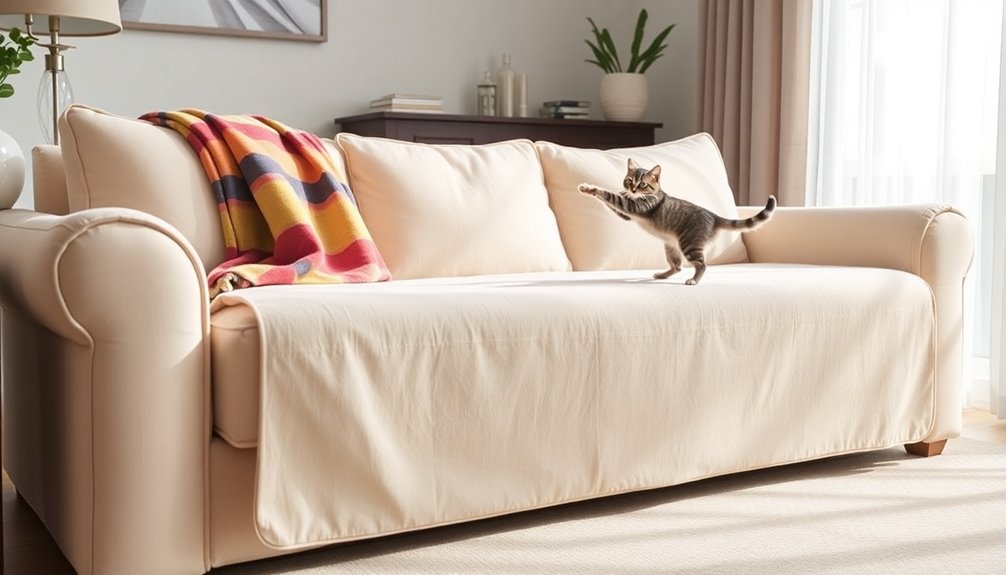
Finding the right protection for your sofa can be a game-changer in maintaining its appearance while keeping your feline friend happy. Start by introducing sofa scratchers, particularly durable options covered in sisal. These encourage your cat to scratch in designated areas, preserving your upholstery. Complement these with scratching posts to further redirect your cat's natural instincts and avoid potential damage to your sofa.
For additional protection, consider using Transparent Clawguard Furniture Shields on vulnerable areas. These long-lasting vinyl shields can be cut to fit your sofa and will deter scratching without ruining its aesthetic. Another effective solution is Sticky Paws double-sided tape, which you can easily apply to the fabric. It discourages cat scratching while allowing your pet to express their natural behavior elsewhere.
Lastly, regularly applying Soft Paws nail caps to your cat's claws can significantly reduce damage. These non-invasive caps allow claw extension and retraction while preventing scratching harm to your furniture. By combining these personalized solutions, you'll create a harmonious space where both your sofa and cat can thrive.
Ongoing Maintenance and Repair Tips
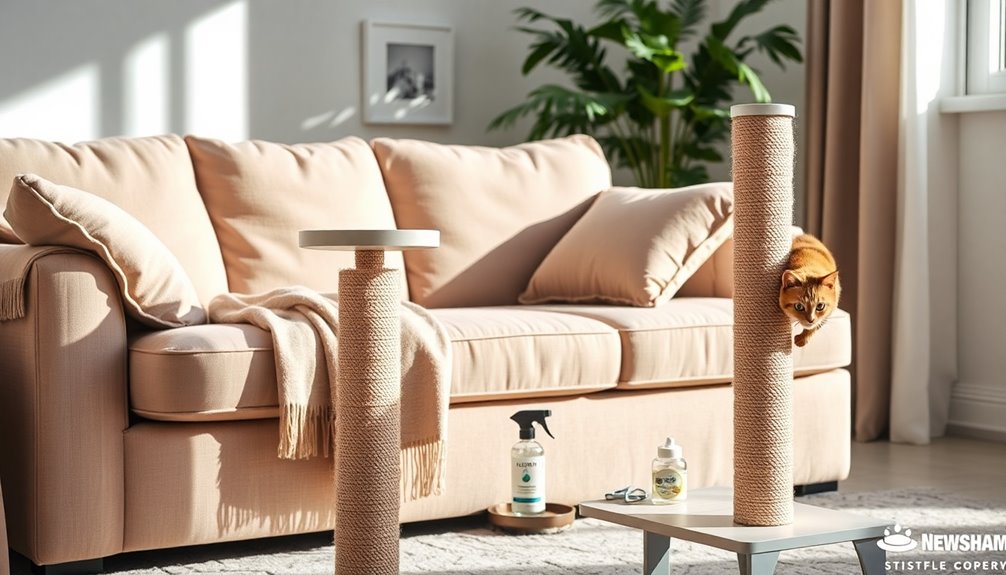
To keep your sofa looking great while accommodating your cat's natural scratching instincts, ongoing maintenance is key. Start by regularly trimming your cat's nails every two to three weeks. This simple step can significantly reduce the potential for damage. Next, invest in high-quality furniture protectors like the FTSTC Anti Cat Scratch Furniture Protector, which offers transparent coverage and lasts for up to two months with proper use.
Consider applying double-sided tape to the areas of your sofa your cat frequents. The sticky sensation often deters them from scratching. Additionally, maintain a consistent cleaning routine to remove fur and debris, as a clean surface minimizes irritation that could lead to scratching.
Don't forget to regularly evaluate your protective measures. If your furniture shields or scratch pads show signs of wear, replace them promptly to ensure they continue to protect your sofa effectively. By staying proactive with these ongoing maintenance tips, you'll help safeguard your furniture while allowing your cat to indulge in their natural behaviors.
Conclusion
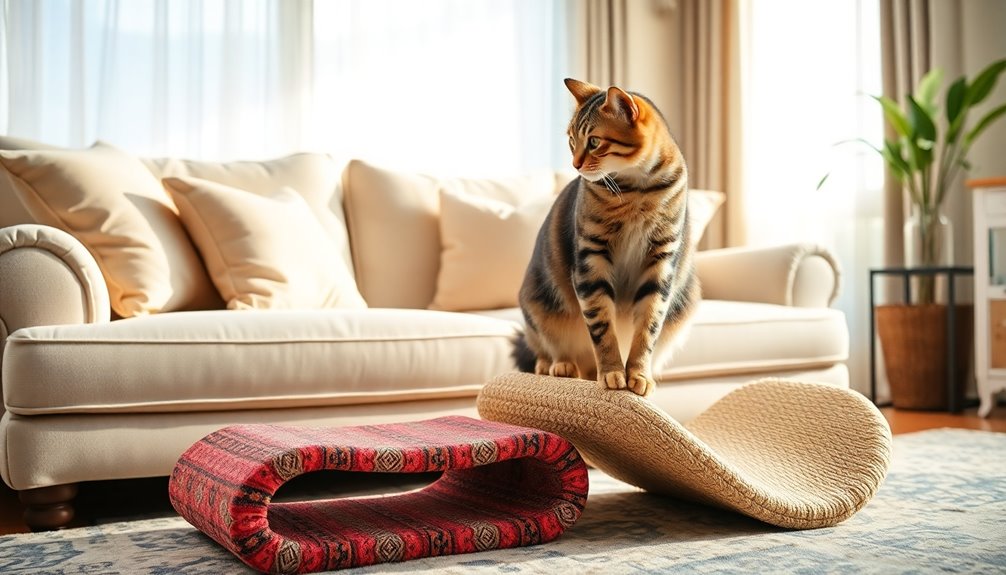
Protecting your sofa from cat scratching is not just about immediate solutions; it's a long-term commitment that requires a combination of strategies. Start by investing in scratch guards for furniture and using protective covers to shield your upholstery. These measures can significantly reduce the risk of damage. Additionally, it's crucial to provide designated scratching posts and floor scratchers to encourage your cat to scratch in appropriate places.
You can also utilize adhesive solutions like Sticky Paws, which are easy to install and remove, helping to deter your cat without leaving any residue. Regular nail trimming and the application of nail caps can further minimize the damage caused by scratching. These small steps can make a big difference in preserving your sofa.
Consistency in training is key. Use positive reinforcement to stop your cat from scratching the furniture and redirect their behavior to the designated posts. By combining these strategies, you'll create a more harmonious environment for both you and your feline friend. Remember, a proactive approach is essential for maintaining the integrity of your sofa while keeping your cat happy and healthy.
Frequently Asked Questions
How Can I Stop My Cat From Scratching My Sofa?
To stop your cat from scratching your sofa, start by providing designated scratching posts made of appealing materials like sisal or cardboard. Place them near the sofa to redirect your cat's behavior. You can also apply double-sided tape on the scratched areas, as the sticky sensation discourages scratching. Regularly trim your cat's nails every couple of weeks, and consider using Soft Paws nail caps for added protection for both your furniture and your cat.
How Do I Protect My Sofa From Cat Scratches?
To protect your sofa from scratches, consider using Sofa Scratchers that fit snugly against your furniture. They encourage your cat to scratch the right surfaces. You can also apply Clawguard Furniture Shields to create a transparent barrier. Try Sticky Paws tape on surfaces to deter scratching, and don't forget to trim your cat's nails regularly. Lastly, consider Nail Caps like Soft Claws to minimize damage while allowing your cat to use its claws naturally.
How to Make Your Sofa Cat Proof?
To make your sofa cat proof, you can start by using furniture guards that fit snugly around corners. Try applying claw shields made of durable vinyl for a discreet barrier. Sticky tape can deter scratching by providing a sticky sensation on your cat's paws. Regularly trim their nails to minimize damage, and consider using nail caps like Soft Paws to prevent scratches while still allowing your cat to retract their claws naturally.
What Can I Spray on My Couch to Keep Cats From Scratching Furniture?
If you're looking for a way to keep cats from scratching your furniture, consider using a commercial cat repellent spray. These sprays often contain strong scents like citronella that deter cats. Alternatively, you can make a homemade solution using water, vinegar, and lemon juice to create an unappealing scent. Just remember to reapply the spray regularly for effectiveness, and always ensure any product you use is safe for your pets.
